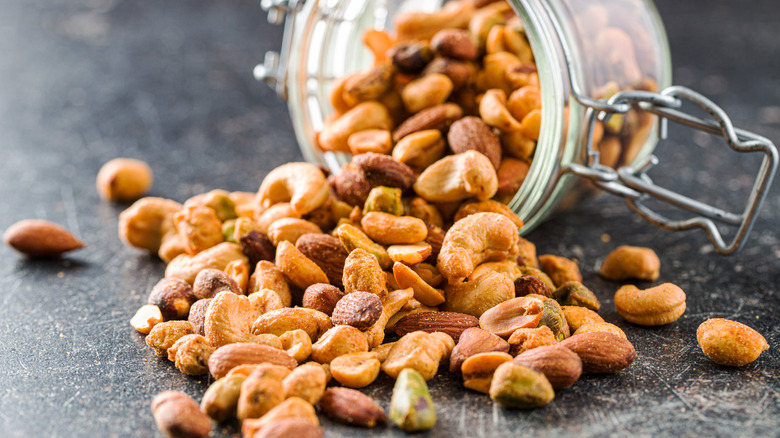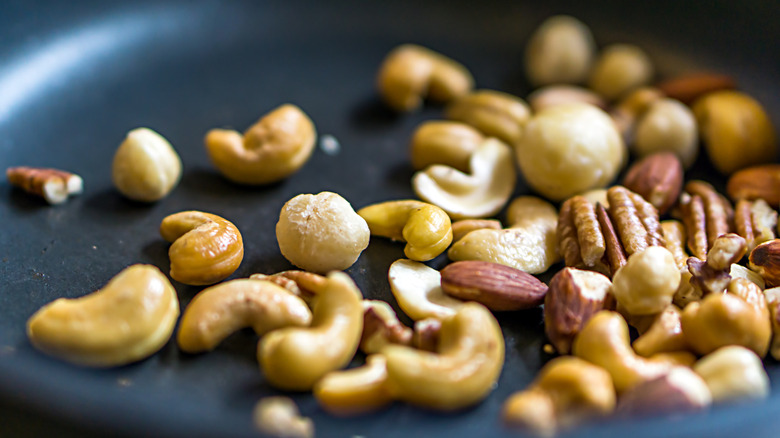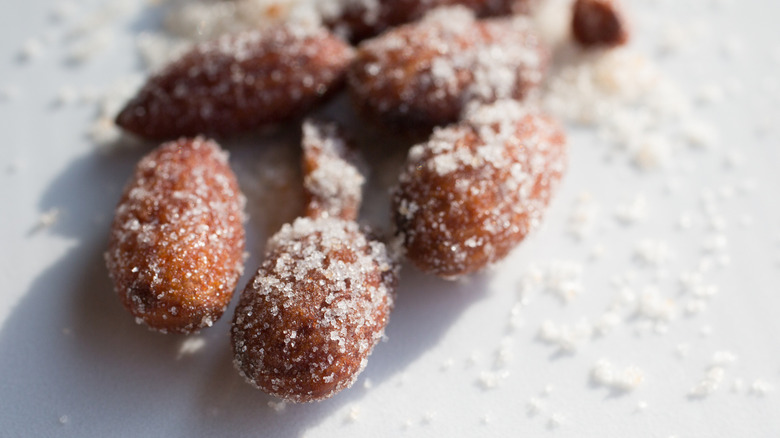How To Roast Nuts At Home And Which Ones Cook Fastest
Roasting greatly elevates the flavor of food like nuts, activating the Maillard reaction (not to be confused with caramelization) to darken their color and enhance both texture and taste. Roasted nuts are a great addition to salads, baked goods like pumpkin bread, and a host of other recipes. But what is the best way to roast nuts at home, and how much time does it take to toast them properly?
To find the answers, Food Republic queried gourmet tour guide and food writer Roberta Muir, who served up some expert insight regarding the best method for toasting nuts, which ones roast the fastest, and how to avoid common mistakes during the at-home toasting process. According to Muir, oven roasting is the best approach for any type of nut, and it's particularly advised for larger varieties like peanuts, almonds, and whole cashews. "All nuts roast most evenly in the oven — where they get constant heat all around them," Muir explained.
"For oven roasting, I spread nuts in a single layer on an oven tray and place them in a preheated 360-degree Fahrenheit oven for 5-10 minutes, depending [on] how dark I want them, stirring them occasionally if necessary, so they [color] evenly," Muir shared. If a mixture of nuts is being roasted, Muir recommended separating them and toasting the different varieties individually, as each type will need a slightly different amount of oven time to achieve an ideal roasted finish. "Smaller nuts (or pieces of nut such as slivered almonds) tend to roast the fastest because they have less surface area to [color]," Muir told us.
A secondary roasting approach for nuts
While Roberta Muir endorsed oven roasting as the best approach, one can also use a stovetop method to get nuts properly toasted. "Small nuts such as pine nuts, or nut pieces like slivered almonds, can also be successfully roasted in a heavy-based frying pan over a medium heat for about 5 minutes," Muir shared. "Pan-roasting requires more constant attention, as the heat is more intense and directed to the surface of the nut in contact with the pan. When pan-roasting, nuts need to be stirred regularly, so they [color] evenly."
When taking the stovetop approach, it's also important to remove the nuts from the frying pan once they've reached the desired color and toastiness. If you don't, the residual heat in the pan will continue cooking them and can burn them, even if the burner is turned off or the pan is removed from the stove.
While pan roasting requires some extra vigilance, one should still also keep a careful eye on nuts that are being roasted in the oven. "Oven-roasting (rather than pan-roasting) is the best way to ensure even [coloring] and is easier as it's more 'set and forget,'" Muir explained. "Though you should still check the nuts after a few minutes, as they may need to be stirred to ensure they [color] evenly."
No matter how you toast the pieces, it's a fairly fast process. "As all nuts are high in oil, they can burn quickly," Muir said, "so whether roasting them in the oven or a pan, it doesn't take long and does require your attention."
Seasoning, sourcing, and storing nuts
Roberta Muir shared that dry-roasting nuts is always the preferred method -– adding oil isn't necessary, as they have plenty of their own. But if someone is toasting nuts to be consumed as a snack rather than incorporated into a recipe, the food expert said to sprinkle on some natural salt. "They're also delicious tossed with all sorts of seasonings, from smoked paprika (hot or sweet) or curry powder to Old Bay seasoning," Muir expounded. "Tips when adding seasoning to roasted nuts: Don't use too much, just a pinch, and toss roasted nuts well with the chosen seasoning while they are still hot so that the natural oils they've released will help the seasoning cling to the nuts."
When working with nuts in any capacity, freshness matters, so make sure you purchase a product that hasn't been languishing on a shelf. Because they are high in oil, nuts can become rancid rapidly. "So, always buy them in small quantities from a Middle Eastern grocer or other store with a high turnover, and store them in the fridge," Muir recommended.



